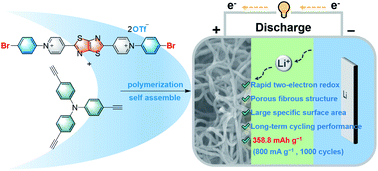A fibrous thiazolothiazole-bridged viologen polymer for high-performance lithium-ion batteries†
Abstract
Development of redox-active conjugated polymers with superior electrochemical performance and a uniform hierarchical structure is a highly rewarding direction for improving the performance of organic hybrid batteries. As a strong electron acceptor, viologen-based compounds have desirable and tunable redox properties, making them suitable candidates for battery applications. In this paper, we disclose the preparation of a fibrous, conjugated porous polymer P1 from the newly designed N,N′-diarylation of dipyridinium thiazolo[5,4-d]thiazole (Py2TTz) building blocks with a promising reversible one-step two-electron redox process. Notably, the fibrous P1 shows a high capacity and excellent cycling stability (nearly 100% capacity retention at a high current density of 800 mA g−1 after 1000 cycles), which are far superior to those of the state-of-the-art viologen materials. This work provides a promising approach for the development of novel organic electrodes for sustainable and durable rechargeable batteries.



 Please wait while we load your content...
Please wait while we load your content...